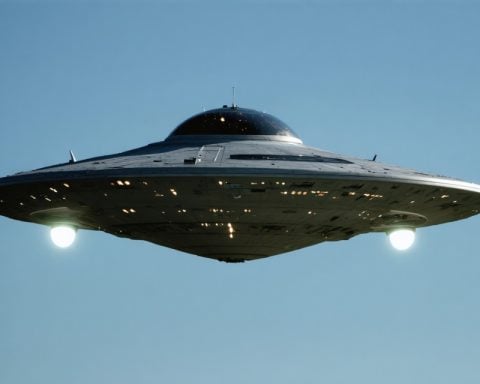Drones and Data: Revolutionizing UFO Sightings Monitoring
In the scenic landscape of central Colombia, Peña de Juaica captivates with tales of unexplained aerial phenomena. But the focus is shifting from ancient stories to futuristic solutions: employing AI-powered drones to unlock the mysteries of the sky. With roots in reports dating back to the early 1990s, this site continues to be a beacon for those eager to understand UFOs. Now, technology stands on the brink of offering unprecedented insights.
The Role of AI in Unveiling Mysteries
Artificial Intelligence is transforming how we interact with and understand the world. By integrating AI with advanced drone technology, researchers can gather detailed data at sites like Peña de Juaica with ease, offering insights that were previously unimaginable. These drones can monitor vast areas, capturing high-definition footage and employing infrared sensors to detect anomalies invisible to the naked eye. The potential for live-streaming this data using AI algorithms can exponentially enhance the understanding of supposed extraterrestrial activities.
Expanding Research Frontiers
This technological advancement elevates Peña de Juaica from a simple tourist destination to a research hub. The once-localized interest in UFO sightings is expanding, with researchers proposing systematic observation through AI-enabled gadgets. Enthusiasts and skeptics alike are intrigued by the possibilities presented by these innovations. Additionally, these explorations could propel a new wave of scientific inquiry into atmospheric and high-altitude phenomena, fascinating broader academic communities.
Embracing Technology for Sustainable Tourism
Besides unraveling UFO mysteries, the use of drones can also foster sustainable tourism. As enthusiasm for Peña de Juaica swells, responsible drone use can mitigate ecological impacts, ensuring the natural beauty of its landscapes remains undisturbed. This dual focus on sustainability and exploration signifies a pioneering path forward for sites around the world.
Peña de Juaica exemplifies the potential of merging technology with curiosity. As visitors look to the skies, the future of understanding Earth’s mysteries is not just in a mystical history but in technological innovation and exploration.
Drones and Data: Charting a New Course for Humanity and the Environment
The integration of AI-powered drones in monitoring mysterious aerial phenomena marks a pivotal shift not only in understanding UFO sightings but also in broader implications for humanity and the environment. As demonstrated in the scenic landscapes of central Colombia’s Peña de Juaica, where technology and ancient lore intertwine, these advancements hold the potential to transform various facets of our world.
Environmental Impact
The use of drones in sensitive areas such as Peña de Juaica offers a noteworthy solution to reducing the ecological footprint of human activities. Traditionally, the exploration of natural sites involves heavy foot traffic, which can degrade landscapes and disturb local wildlife. Drones equipped with AI can minimize the physical presence required by researchers and tourists by capturing high-resolution images and data from afar. This remote operation ensures that ecosystems remain undisturbed, contributing positively to biodiversity conservation efforts.
Moreover, drones can be integral in monitoring environmental changes. By consistently collecting data, they can detect shifts in weather patterns, vegetation health, and even pollution levels, offering invaluable information for environmental scientists and conservationists. This capability is particularly pertinent in the face of climate change, providing tools to anticipate and mitigate its impacts.
Future of Humanity
The incorporation of drones and AI in uncovering the unknown offers a glimpse into humanity’s future—a future where exploration is seamless, data-rich, and less invasive to our planet. This technological evolution fosters a culture of curiosity and learning, encouraging new generations to engage in scientific inquiry and tech innovation. As we stand on the precipice of exploring outer phenomena, such tools may even pave the way for understanding our broader universe, preparing us for potential interstellar exploration.
Alongside scientific advancement, such technology can inspire a global reconsideration of what is possible when humanity collaborates across cultural and national boundaries in pursuit of knowledge. The melding of ancient mysteries with cutting-edge technology at Peña de Juaica exemplifies how tradition and innovation can coalesce, leading to greater societal understanding and cooperative progress.
Economic Implications
Economically, the transformative use of AI and drones can spawn new industries, from technology development and manufacturing to data analysis and tourism. Sites like Peña de Juaica can attract global attention, creating jobs and fostering economic growth in remote areas. Moreover, as sustainable tourism becomes a priority, local economies can thrive by positioning themselves as custodians of both cultural heritage and progressive environmental stewardship.
In conclusion, the deployment of AI-powered drones to study UFO sightings extends beyond the realm of curiosity—it signals a significant environmental and societal paradigm shift. By adopting these technologies, humanity is embracing a future where exploration and preservation are inherently linked, ensuring that our pursuit of knowledge supports the Earth’s ecological balance and enriches our shared human experience.
AI-Powered Drones: The Future of UFO Research and Beyond
Innovative Features of AI-Powered Drones
AI-powered drones are at the forefront of modern research, particularly in the domain of UFO sightings. Equipped with high-resolution cameras and advanced infrared sensors, these drones can gather data around the clock, offering unparalleled insights into phenomena like those observed at Peña de Juaica. The integration of AI enhances these capabilities by enabling real-time data analysis, anomaly detection, and machine learning models to predict and categorize sightings.
Pros and Cons of AI-Driven Research
Pros:
– Accuracy and Precision: AI algorithms can analyze vast amounts of data quickly, reducing human error.
– Accessibility: Drones can access remote areas, providing coverage where human presence is limited or dangerous.
– Cost-Effective: Automated analysis reduces the need for large research teams on-site, lowering overall expenses.
Cons:
– Privacy Concerns: The pervasive use of drones raises privacy issues for surrounding communities.
– Technical Malfunctions: The reliance on technology can lead to problems if drones encounter unexpected software or hardware failures.
– Dependence on Data Quality: Poor data quality can lead to inaccurate conclusions, emphasizing the need for high-quality inputs.
Use Cases Beyond UFO Sightings
Beyond uncovering aerial phenomena, AI-driven drone technology has wide-ranging applications. In agriculture, drones are revolutionizing crop monitoring through precision agriculture techniques, offering critical insights into crop conditions, pest infestations, and needs for fertilizers. In search and rescue operations, they assist by surveying large areas quickly and locating individuals in distress. Additionally, infrastructure inspection, wildlife conservation, and even film production are leveraging drones’ adaptability and efficiency.
Potential Limitations of Drone Technology
Despite the benefits, drone technology is not without limitations. Battery life remains a significant constraint, limiting flight duration and requiring frequent recharging or battery swaps. Additionally, weather conditions can obstruct optimal performances, such as strong winds or rain, affecting data accuracy.
Market Trends and Innovations
The drone industry is witnessing rapid innovation with the development of more sophisticated AI models and sensor technologies. Trends suggest an increase in autonomous drone capabilities, allowing for fully independent operations without constant human oversight. As regulations around drone usage evolve globally, markets are expanding to integrate drones into urban air mobility solutions, paving the path for new industries and applications.
Predictions for the Future
Looking forward, AI-powered drones are expected to play a pivotal role in not only unraveling the mysteries of UFO sightings but also influencing various sectors. Enhanced AI capabilities, combined with evolving data management strategies, could lead to breakthroughs in predicting atmospheric phenomena, as well as unexplored frontiers in societal applications. The potential for drones to integrate with augmented reality systems may offer fresh perspectives in education, tourism, and entertainment.
For extensive market insights and the latest trends about drones and emerging technology, visit Futurism. This platform provides up-to-date information on technological advancements shaping the future.



















